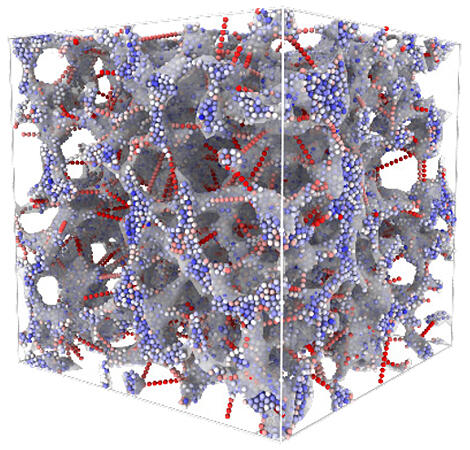Professor Emeritus (Senior Program Advisor) Hajime Tanaka, Project Researcher Jiaxing Yuan, Project Research Associate Michio Tateno, and their colleagues of the High Performance Materials Laboratory in the Research Center for Advanced Science and Technology at the University of Tokyo have announced that they have successfully reproduced the formation of network structures associated with the viscoelastic phase separation of polymer solutions using numerical simulations that correctly incorporate the effects of solvent flow. This achievement is expected to provide important insights into industrial processes that form network structures and intracellular phase-separation phenomena. The results were published in the September 7, 2023 issue of the international journal ACS Nano.

Provided by the University of Tokyo
Phase separation is a common phenomenon in daily life. For example, when salad dressing is shaken well, its droplets increase in size over time and eventually separate into oil and water phases, a process called demixing. In this general phase-separation phenomenon, a low-volume phase forms spherical droplets in a high-volume parent phase.
By contrast, in polymer solutions, the dense polymer phase, which is the minority phase, forms a network structure, and the network structure grows over time. This unique phenomenon is called viscoelastic phase separation because of the viscoelasticity of the phase with slow dynamics. It is also observed in colloidal dispersion systems, in which the characteristic size of the network is reported to increase with time t according to a power-growth law, (t1/2).
This power law does not hold true for polymer solutions, but the relevant mechanism remains unknown. By performing large-scale simulations incorporating the degrees of freedom of many-body solvent flow, the research group found that when the temperature is lowered to a certain value (the quenching temperature), the rate of phase separation is faster than the movement of polymer chains, and the chains cannot keep up with the domain deformation induced by phase separation. As a result, the polymer chains are considerably stretched, and viscoelastic stress is generated.
The viscoelastic stresses resulting from the large internal degrees of freedom of the polymers prevent the self-similar growth of phase-separation structures. In addition, statistical investigations of quenching and polymer chain length revealed that the region of non-self-similar growth was significantly extended for longer chain lengths. This result indicates that the longer the polymer chain, the deeper the quenching, the greater the polymeric characteristics exhibited, and the greater the tendency for self-similarity to be broken.
This finding is expected to provide new fundamental knowledge in various fields in which network structure plays an important role, such as the understanding of intracellular phase separation and porous material formation, which have attracted increased attention in recent years.
Tanaka said, "The phenomenon of viscoelastic phase separation in polymer solution systems, which we discovered about 30 years ago, has substantially overturned traditional theoretical predictions of phase separation. In conventional phase separation, the minority phase usually forms droplets, as we see in salad dressings. However, in the phase separation of polymer solutions, the polymer-rich phases can form network structures even when they are the minority phase."
"This phenomenon is expected to be useful for understanding phase separation in cells, which has received much attention recently, and in designing separation membranes. To date, this phenomenon has been explained using a phenomenological approach, but our simulation succeeded in unraveling the mechanism at the microscopic level by accurately incorporating solvent flow and clarifying the behavior of the polymer chains. This achievement represents a major advancement in our understanding of the nature of the phenomenon."
Journal Information
Publication: ACS Nano
Title: Mechanical Slowing Down of Network-Forming Phase Separation of Polymer Solutions
DOI: 10.1021/acsnano.3c04657
This article has been translated by JST with permission from The Science News Ltd. (https://sci-news.co.jp/). Unauthorized reproduction of the article and photographs is prohibited.




